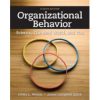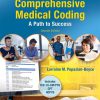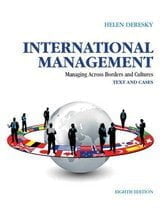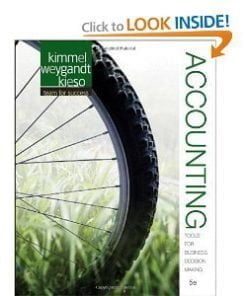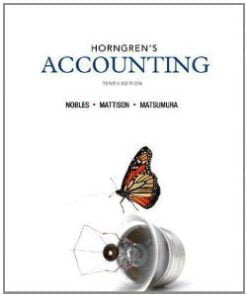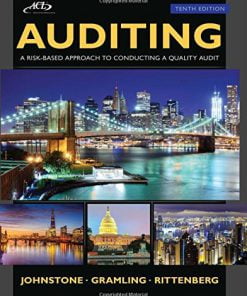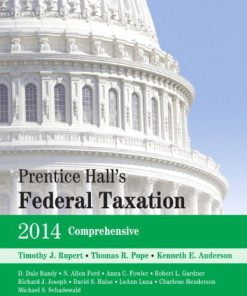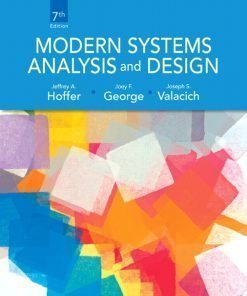Advanced Accounting Fischer 10th Edition Solutions Manual
$35.00 Original price was: $35.00.$26.50Current price is: $26.50.
Advanced Accounting Fischer 10th Edition Solutions Manual
Instant download Advanced Accounting Fischer 10th Edition Solutions Manual pdf docx epub after payment.
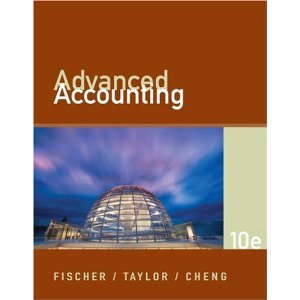
Chapter 1
Understanding the Issues
- (a) Horizontal combination—both are marine engine manufacturers
(b) Vertical combination—manufacturer buys distribution outlets
(c) Conglomerate—unrelated businesses
- By accepting cash in exchange for the net assets of the company, the seller would have to recognize an immediate taxable gain. However, if the seller were to accept common stock of another corporation instead, the seller could construct the transaction as a tax-free reorganization. The seller could then account for the transaction as a tax-free exchange. The seller would not pay taxes until the shares received were sold.
- Identifiable assets (fair value)……. $600,000
Deferred tax liability
($200,000 × 40%)…………………. (80,000)
Net assets…………………………….. $520,000
Goodwill
Price paid……………………………… $850,000
Net assets…………………………….. (520,000)
Goodwill……………………………….. $330,000
- (a) The net assets and goodwill will be recorded at their full fair value on the books of the parent on the date of acquisition.
(b) The net assets will be “marked up” to fair value, and goodwill will be recorded at the end of the fiscal year when the consolidated financial statements are prepared through the use of a consolidated worksheet.
- Puncho will record the net assets at their fair value of $800,000 on its books. Also, Puncho will record goodwill of $100,000 ($900,000 – $800,000) resulting from the excess of the price paid over the fair value. Semos will record the removal of its net assets at their book values. Semos will record a gain on the sale of business of $500,000 ($900,000 – $400,000).
- (a) Value Analysis:
Price paid……………………….. $ 800,000
Fair value of net assets……… 520,000
Goodwill…………………………. $ 280,000
Current assets (fair value)…… $ 120,000
Land (fair value)…………………… 80,000
Building & equipment
(fair value)………………………. 400,000
Customer list (fair value)………… 20,000
Liabilities (fair value)…………… (100,000)
Goodwill…………………………. 280,000
Total……………………………… $ 800,000
(b) Value Analysis:
Price paid……………………….. $ 450,000
Fair value of net assets……… 520,000
Gain………………………………. $ (70,000)
Current assets (fair value)…… $ 120,000
Land (fair value)…………………… 80,000
Building & equipment
(fair value)………………………. 400,000
Customer list (fair value)………… 20,000
Liabilities (fair value)…………… (100,000)
Gain………………………………. (70,000)
Total……………………………… $ 450,000
- The 20X1 financial statements would be revised as they are included in the 20X2 – 20X1 comparative statements. The 20X2 statements would be based on the new values. The adjustments would be:
(a) The equipment and building will be restated at $180,000 and $550,000 on the comparative 20X1 and 20X2 balance sheets.
(b) Originally, depreciation on the equipment was $40,000 ($200,000/5) per year. It will be recalculated as $36,000 ($180,000/5) per year. The adjustment for 20X1 is for a half year. 20X1 depreciation expense and accumulated depreciation will be restated at $18,000 instead of $20,000 for the half year. Depreciation expense for 20X2 will be $36,000.
- Originally, depreciation on the building was $25,000 ($500,000/20) per year. It will be recalculated as $27,500 ($550,000/20) per year. The adjustment for 20X1 is for a half year. 20X1 depreciation expense and accumulated depreciation will be restated at $13,750 instead of $12,500 for the half year. Depreciation expense for 20X2 will be $27,500.
(d) Goodwill is reduced $30,000 on the comparative 20X1 and 20X2 balance sheets.
- Fair value of operating unit…… $1,200,000
Book value including goodwill.. 1,250,000
Goodwill is impaired
Fair value of operating unit…… $1,200,000
Fair value of net identifiable
assets……………………………. 1,120,000
Recalculated goodwill…………. 80,000
Existing goodwill………………… 200,000
Goodwill impairment loss……… $ 120,000
- (a) An estimated liability should have been recorded on the purchase date. Any difference between that estimate and the $100,000 paid would be recorded as a gain or loss on the liability already recorded.
(b) Even though the issuance is based on performance and suggests additional goodwill, no adjustment is made if additional stock is issued. In this case, the paid-in capital in excess of par account is reduced for the par value of the additional shares to be issued. The fair value of the stock originally issued is being devalued.
The entry would take the following form:
Paid-In Capital in
Excess of Par……….. 10,000
Common Stock
($1 par)……….. 10,000
(c) This agreement is also settled by issuing shares. The price is not changed. The paid-in capital in excess of par account is reduced for the par value of the additional shares to be issued. The fair value of the stock originally issued is being devalued.
The entry would take the following form:
Paid-In Capital in
Excess of Par……….. 5,000
Common Stock
($1 par)……….. 5,000
EXERCISES
EXERCISE 1-1
(1) Current Assets………………………………………………………………… 100,000
Land………………………………………………………………………………. 75,000
Building…………………………………………………………………………… 300,000
Equipment………………………………………………………………………. 275,000
Goodwill………………………………………………………………………….. 152,000
Liabilities…………………………………………………………………….. 102,000
Cash…………………………………………………………………………… 800,000
Expenses (acquisition costs)…………………………………………….. 15,000
Cash…………………………………………………………………………… 15,000
(2) Cash………………………………………………………………………………. 800,000
Liabilities…………………………………………………………………………. 100,000
Accumulated Depreciation—Building…………………………………. 200,000
Accumulated Depreciation—Equipment……………………………… 100,000
Current Assets…………………………………………………………….. 80,000
Land…………………………………………………………………………… 50,000
Building………………………………………………………………………. 450,000
Equipment…………………………………………………………………… 300,000
Gain on Sale of Business……………………………………………… 320,000
Note: Seller does not receive the acquisition costs.
(3) Investment in Crow Company……………………………………………. 800,000
Cash…………………………………………………………………………. 800,000
Expenses (acquisition costs)…………………………………………….. 15,000
Cash…………………………………………………………………………. 15,000
Note: At year-end, Crow would be consolidated with Bart, as explained in Chapter 2.
EXERCISE 1-2
Cash……………………………………………………………………………………… 100,000
Inventory……………………………………………………………………………….. 250,000
Equipment……………………………………………………………………………… 220,000
Land……………………………………………………………………………………… 180,000
Buildings……………………………………………………………………………….. 300,000
Goodwill*……………………………………………………………………………….. 640,000
Discount on Bonds Payable…………………………………………………….. 140,000
Current Liabilities………………………………………………………………. 80,000
Bonds Payable…………………………………………………………………. 550,000
Common Stock…………………………………………………………………. 300,000
Paid-In Capital in Excess of Par………………………………………….. 900,000
Acquisition Expense……………………………………………………………….. 25,000
Paid-In Capital in Excess of Par……………………………………………….. 10,000
Cash………………………………………………………………………………… 35,000
*Total consideration:
Common stock (60,000 shares × $20)…………………………………. $1,200,000
Less fair value of net assets acquired:
Cash…………………………………………………………………………… $100,000
Inventory…………………………………………………………………….. 250,000
Equipment ………………………………………………………………….. 220,000
Land…………………………………………………………………………… 180,000
Buildings…………………………………………………………………….. 300,000
Current liabilities………………………………………………………….. (80,000)
Bonds payable…………………………………………………………….. (410,000)
Value of net identifiable assets acquired………………………… 560,000
Excess of total cost over fair value of net assets (goodwill)…………. $ 640,000
EXERCISE 1-3
Accounts Receivable ……………………………………………………………… 100,000
Inventory……………………………………………………………………………….. 210,000
Equipment for Resale……………………………………………………………… 72,000
Land……………………………………………………………………………………… 200,000
Building…………………………………………………………………………………. 450,000
R&D Project…………………………………………………………………………… 90,000
Customer List…………………………………………………………………………. 210,650
Goodwill*……………………………………………………………………………….. 477,350
Current Liabilities………………………………………………………………. 80,000
Bonds Payable…………………………………………………………………. 200,000
Warranty Liability………………………………………………………………. 30,000
Common Stock…………………………………………………………………. 100,000
Paid-In Capital in Excess of Par………………………………………….. 1,400,000
*Total consideration:
Common stock (100,000 shares × $15)……………………………….. $1,500,000
Less fair value of net assets acquired:
Accounts receivable…………………………………………………….. $ 100,000
Inventory…………………………………………………………………….. 210,000
Equipment for resale ($80,000 less 10%)……………………….. 72,000
Current liabilities………………………………………………………….. (80,000)
Bonds payable…………………………………………………………….. (200,000)
Land…………………………………………………………………………… 200,000
Building………………………………………………………………………. 450,000
R&D project………………………………………………………………… 90,000
Customer list ($100,000 payment discounted 3 years at 20%) 210,650
Estimated liability under warranty…………………………………………….. (30,000)
Value of net identifiable assets acquired…………………………………… 1,022,650
Excess of total cost over fair value of net assets (goodwill)…………. $ 477,350
EXERCISE 1-4
Accounts Receivable………………………………………………………………. 200,000
Inventory……………………………………………………………………………….. 270,000
Equipment …………………………………………………………………………….. 40,000
Brand-Name Copyright……………………………………………………………. 15,000
Cash………………………………………………………………………………… 160,000
Current Liabilities………………………………………………………………. 80,000
Mortgage Payable…………………………………………………………….. 250,000
Gain on Acquisition*………………………………………………………….. 35,000
Acquisition Expense……………………………………………………………….. 25,000
Cash………………………………………………………………………………… 25,000
*Total consideration:
Cash………………………………………………………………………………… $160,000
Less fair value of net assets acquired:
Accounts receivable…………………………………………………….. $ 200,000
Inventory…………………………………………………………………….. 270,000
Equipment…………………………………………………………………… 40,000
Brand-name copyright………………………………………………….. 15,000
Current liabilities………………………………………………………….. (80,000)
Mortgage payable………………………………………………………… (250,000)
Value of net identifiable assets acquired………………………… 195,000
Excess of total fair value over cost of net assets (gain)………………. $ (35,000)
EXERCISE 1-5
(1) Adjustments:
Final value of manufacturing plant……………………………………………………… $700,000
Provisional value of manufacturing plant…………………………………………….. 600,000
Total increase………………………………………………………………………………….. $100,000
Depreciation adjustment:
Depreciation on final cost ($700,000/10 years)………………. $70,000
Depreciation based on provisional cost ($600,000/10 years) 60,000
Annual increase in depreciation……………………………………. $10,000
Adjustment for half year………………………………………………. $5,000
Journal Entries:
Plant Assets………………………………………………………………. 100,000
Goodwill………………………………………………………………… 100,000
Retained Earnings (increase depreciation for half year)….. 5,000
Plant Assets (because they are shown net
of depreciation)……………………………………………………. 5,000
(2) Balance Sheet
December 31, 20X1 (revised)
Current assets……………. $ 300,000 Current liabilities……………….. $ 300,000
Equipment (net)………….. 600,000 Bonds payable………………….. 500,000
Plant assets (net)……….. 1,695,000 Common stock ($1 par)……… 50,000
Goodwill…………………….. 200,000 Paid-in capital in excess of par 1,300,000
Retained earnings…………….. 645,000
Total assets……………….. $2,795,000 Total liabilities and equity…… $2,795,000
Summary Income Statement
For Year Ended December 31, 20X1 (revised)
Sales revenue…………………………………………………………………. $800,000
Cost of goods sold…………………………………………………………… 520,000
Gross profit……………………………………………………………………… $280,000
Operating expenses…………………………………………………………. $150,000
Depreciation expense………………………………………………………. 85,000 235,000
Net income……………………………………………………………………… $ 45,000
EXERCISE 1-6
Machine = $200,000
Deferred tax liability = $16,800
In this tax-free exchange, depreciation on $56,000 [($200,000 appraised value) – ($144,000* net book value)] of the machine’s value is not deductible on future tax returns. The additional tax to be paid as a result of Lewison’s inability to deduct the excess value assigned to the machine is $16,800 ($56,000 × 30%).
Goodwill = $800,000 – ($700,000 – $16,800)
= $116,800
*$180,000/10 yrs. × 2 prior years = $36,000 accumulated depreciation
$180,000 – $36,000 = $144,000 net book value
EXERCISE 1-7
Current Assets……………………………………………………………………….. 100,000
Equipment……………………………………………………………………………… 200,000
Building…………………………………………………………………………………. 270,000
Deferred Tax Asset…………………………………………………………………. 120,000
Goodwill*……………………………………………………………………………….. 270,000
Current Liabilities………………………………………………………………. 60,000
Cash………………………………………………………………………………… 900,000
Price paid………………………………………………………………………………. $ 900,000
Less fair value of net assets:
Current assets………………………………………………………………….. $100,000
Equipment………………………………………………………………………… 200,000
Building……………………………………………………………………………. 270,000
Recorded (current) liabilities……………………………………………….. (60,000) 510,000
Excess………………………………………………………………………………….. $ 390,000
*Tax loss carryforward consideration:
Deferred tax asset ($400,000 × 30%) = the value of the
remaining carryforward…………………………………………………. (120,000)
Goodwill ……………………………………………………………………………….. $ 270,000
EXERCISE 1-8
(1) Liabilities…………………………………………………………………………. 40,000
Loss on Contingent Payment…………………………………………….. 20,000
Cash…………………………………………………………………………. 60,000
2 × (average income of $55,000* – $25,000) less $40,000 liability already recorded.
*($50,000 + $60,000)/2 = $55,000
(2) Shares issued = $60,000/$5 per share = 12,000 shares
Since the contingency is settled in shares, goodwill is not increased and cash is not changed. The entry to record the 12,000 additional shares issued is as follows:
Paid-In Capital in Excess of Par………………………………………… 12,000
Common Stock ($1 par)………………………………………………. 12,000
(3) Paid-In Capital in Excess of Par………………………………………… 50,000
Common Stock ($1 par)………………………………………………. 50,000
Deficiency [($6 – $4) × 100,000 shares]……………………………… $200,000
Divide by fair value…………………………………………………………… ÷ $4
Added number of shares…………………………………………………… 50,000
EXERCISE 1-9
(1) Purchase price……………………………………………………………………………………… $600,000
Fair value of net assets other than goodwill……………………………………………… 400,000
Goodwill……………………………………………………………………………………………….. $200,000
The estimated value of the unit exceeds $600,000, confirming goodwill.
(2) (a) Estimated fair value of business unit………………………………………………….. $520,000
Book value of Anton net assets, including goodwill……………………………… $500,000
No impairment exists.
(b) Estimated fair value of business unit………………………………………………….. $400,000
Book value of Anton net assets, including goodwill……………………………… $450,000
Goodwill is impaired.
Estimated fair value of business units………………………………………………… $400,000
Fair value of net assets, excluding goodwill………………………………………… 340,000
Remeasured amount of goodwill……………………………………………………….. $ 60,000
Existing goodwill………………………………………………………………………………. 200,000
Impairment loss……………………………………………………………………………….. $140,000
APPENDIX EXERCISE
EXERCISE 1A-1
(1) Calculation of Earnings in Excess of Normal:
Average operating income:
20X1………………………………………………………………. $ 90,000
20X2………………………………………………………………. 110,000
20X3………………………………………………………………. 120,000
20X4 (subtract $40,000)…………………………………… 100,000
20X5………………………………………………………………. 130,000
$550,000 ÷ 5 years = $110,000
Less normal return on assets at fair value:
Accounts receivable…………………………………….. $100,000
Inventory…………………………………………………….. 125,000
Land…………………………………………………………… 100,000
Building………………………………………………………. 300,000
Equipment…………………………………………………… 250,000
Fair value of total assets…………………………………… $875,000
Industry normal rate of return……………………………. × 12%
Normal return on assets……………………………….. 105,000
Expected annual earnings in excess of normal…………. $ 5,000
(a) 5 × $5,000 = $25,000 Goodwill
(b) Capitalize the perpetual yearly earnings at 12%:
Goodwill =
=
= $41,667
(c) Present value of a $5,000 annuity capitalized at 16%. The correct present value factor is found in the “present value of an annuity of $1” table, at 16% for 5 periods. This factor multiplied by the $5,000 yearly excess earnings will result in the present value:
3.2743 × $5,000 = $16,372
(2) The goodwill recorded would be $15,000. The journal entry (not required) would be as
follows:
Accounts Receivable……………………………………………………….. 100,000
Inventory…………………………………………………………………………. 125,000
Land………………………………………………………………………………. 100,000
Building…………………………………………………………………………… 300,000
Equipment………………………………………………………………………. 250,000
Goodwill………………………………………………………………………….. 15,000
Cash…………………………………………………………………………. 690,000
Total Liabilities…………………………………………………………… 200,000
problems
problem 1-1
(1) Acquisition price $500,000
Total consideration:
Cash…………………………………………………………………………… $500,000
Less fair value of net assets acquired:
Accounts receivable…………………………………………………….. $ 79,000
Inventory…………………………………………………………………….. 120,000
Other current assets…………………………………………………….. 55,000
Equipment…………………………………………………………………… 307,000
Trademark………………………………………………………………….. 27,000
In-process R&D…………………………………………………………… 14,000
Current liabilities………………………………………………………….. (145,000)
Bonds payable…………………………………………………………….. (100,000)
Value of net identifiable assets acquired…………………… 357,000
Excess of total cost over fair value of net assets (goodwill)…… $143,000
Journal Entry:
Accounts Receivable……………………………………………………. 79,000
Inventory…………………………………………………………………….. 120,000
Other Current Assets……………………………………………………. 55,000
Equipment…………………………………………………………………… 307,000
Trademark………………………………………………………………….. 27,000
R&D Expense……………………………………………………………… 14,000
Goodwill……………………………………………………………………… 143,000
Cash……………………………………………………………………… 500,000
Current Liabilities……………………………………………………. 145,000
Bonds Payable………………………………………………………. 100,000
Dr. = Cr. Check Totals 745,000 745,000
Problem 1-1, Concluded
(2) Acquisition price $300,000
Total consideration:
Cash…………………………………………………………………………… $300,000
Less fair value of net assets acquired:
Accounts receivable…………………………………………………….. $ 79,000
Inventory…………………………………………………………………….. 120,000
Other current assets…………………………………………………….. 55,000
Equipment ………………………………………………………………….. 307,000
Trademark………………………………………………………………….. 27,000
In-process R&D…………………………………………………………… 14,000
Current liabilities………………………………………………………….. (145,000)
Bonds payable…………………………………………………………….. (100,000)
Value of net identifiable assets acquired…………………… 357,000
Excess of fair value of net assets over cost (gain)……………….. $ (57,000)
Journal Entry:
Accounts Receivable……………………………………………………. 79,000
Inventory…………………………………………………………………….. 120,000
Other Current Assets……………………………………………………. 55,000
Equipment…………………………………………………………………… 307,000
Trademark………………………………………………………………….. 27,000
R&D Expense……………………………………………………………… 14,000
Gain on Business Acquisition…………………………………… 57,000
Cash……………………………………………………………………… 300,000
Current Liabilities……………………………………………………. 145,000
Bonds Payable………………………………………………………. 100,000
Dr. = Cr. Check Totals 602,000 602,000
Related products
Solution Manual
Solution Manual
Solution Manual for Absolute C++, 5/E 5th Edition Walter Savitch
Solution Manual
Solution manual for Accounting: Tools for Business Decision Making Kimmel Weygandt Kieso 5th Edition
Solution Manual
Auditing A Risk Based-Approach to Conducting a Quality Audit Johnstone 10th Edition Solutions Manual
Solution Manual
Prentice Hall’s Federal Taxation 2014 Comprehensive Rupert 27th Edition Solutions Manual
Solution Manual


